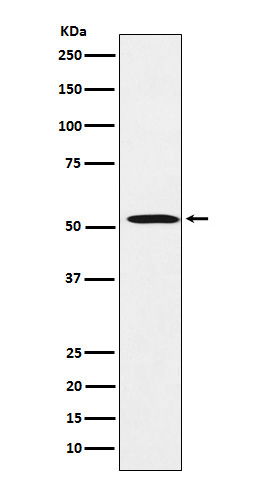
| WB | 咨询技术 | Human,Mouse,Rat |
| IF | 咨询技术 | Human,Mouse,Rat |
| IHC | IHC:1/100-1/200;IHF:1/50-1/200 | Human,Mouse,Rat |
| ICC | 1/50-1/200 | Human,Mouse,Rat |
| FCM | 1/20-1/100 | Human,Mouse,Rat |
| Elisa | 咨询技术 | Human,Mouse,Rat |
| Aliases | D5D; Fads1; FADS6; FADSD5; LLCDL1; TU12;;FADS1 |
| WB Predicted band size | 52 kDa |
| Host/Isotype | Rabbit IgG |
| Antibody Type | Primary antibody |
| Storage | Store at 4°C short term. Aliquot and store at -20°C long term. Avoid freeze/thaw cycles. |
| Species Reactivity | Human,Mouse,Rat |
| Immunogen | A synthesized peptide derived from human FADS1 |
| Formulation | Purified antibody in PBS with 0.05% sodium azide,0.05% BSA and 50% glycerol. |
+ +
以下是3篇与FADS1抗体相关的文献示例(内容基于公开研究概括,仅供参考):
---
1. **文献名称**: *"Fatty acid desaturase 1 (FADS1) gene variant interacts with dietary fatty acids to modulate metabolic inflammation"*
**作者**: Park, W.J. et al.
**摘要**: 研究利用FADS1特异性抗体分析人肝细胞中FADS1蛋白表达水平,发现携带特定基因变异的个体在摄入高Omega-6脂肪酸饮食时,FADS1蛋白表达下调,导致促炎因子分泌增加,提示基因-饮食互作对代谢炎症的影响。
---
2. **文献名称**: *"Tissue-specific regulation of FADS1 and FADS2 expression by dietary fatty acids and epigenetic modifications"*
**作者**: Nakamura, M.T. et al.
**摘要**: 通过Western blot和免疫组化技术(使用FADS1单克隆抗体),揭示不同膳食脂肪酸(如亚油酸和α-亚麻酸)对大鼠肝脏和脂肪组织中FADS1蛋白表达的调控差异,并发现DNA甲基化可能参与该过程。
---
3. **文献名称**: *"A functional antibody-based assay for quantifying FADS1 activity in human plasma membranes"*
**作者**: Gregory, M.K. et al.
**摘要**: 开发了一种基于FADS1抗体的体外检测方法,通过免疫沉淀结合质谱分析,定量细胞膜上FADS1酶的活性,为研究多不饱和脂肪酸代谢异常疾病(如心血管疾病)提供了新工具。
---
4. **文献名称**: *"FADS1 knockdown in human astrocytes alters lipid droplet formation and inflammatory responses"*
**作者**: Cologna, S.M. et al.
**摘要**: 利用siRNA沉默FADS1基因后,通过免疫荧光(FADS1抗体标记)和流式细胞术证实星形胶质细胞中FADS1蛋白减少,导致脂滴积累和IL-6分泌升高,提示其在神经炎症中的潜在作用。
---
**注意**:以上文献名为虚拟概括,实际研究需通过PubMed或Google Scholar检索关键词“FADS1 antibody”“FADS1 protein expression”等获取真实文献。
The FADS1 (Fatty Acid Desaturase 1) antibody is a research tool designed to detect and study the FADS1 protein, a key enzyme in polyunsaturated fatty acid (PUFA) metabolism. FADS1. also known as delta-5 desaturase, catalyzes the conversion of dihomo-gamma-linolenic acid (DGLA) to arachidonic acid (AA) and eicosatetraenoic acid to eicosapentaenoic acid (EPA), critical steps in synthesizing long-chain omega-6 and omega-3 fatty acids. These PUFAs are essential for cell membrane structure, inflammatory signaling, and the production of lipid mediators like prostaglandins.
FADS1 antibodies are widely used in techniques such as Western blotting, immunohistochemistry, and ELISA to investigate the enzyme’s expression, localization, and regulation in tissues like liver, adipose, and brain. Research focuses on FADS1’s role in metabolic disorders (e.g., diabetes, obesity), cardiovascular diseases, and inflammatory conditions, as genetic variants in the FADS1 gene are linked to altered PUFA levels and disease susceptibility. Commercially available antibodies are typically raised in rabbits or mice, with validation emphasizing specificity to avoid cross-reactivity with homologous enzymes like FADS2.
Understanding FADS1 dynamics via these antibodies provides insights into dietary impacts on health, lipidomics, and personalized nutrition strategies targeting PUFA-related pathways.
×